Winter is upon us and that means stinging nettles. It’s too warm in Florida most of the year for any Urtica to thrive. But the cooler weather from about Christmas to Valentines Day coaxes up our “burning dwarf.” And make no mistake: Urtica chamaedryoides is not like the gentle stinging nettle found in northern climes. It is a potent assailant that is nutritious when handled carefully and very painful when not. A sting from this nettle burns me for days and leaves welts. Animals are also not immune. Here’s what the University of Florida has to say about that:
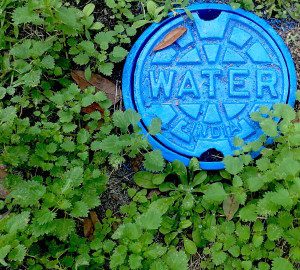
This was my first sighting of nettles this season. They were spied in southwest Volusia County. Photo by Green Deane
“Fireweed is particularly troublesome because it possesses stinging hairs that easily embed in skin. Once exposed to the toxin, severe irritation can occur for several hours. Though generally avoided by cattle, horses are more likely to browse fireweed and develop stress symptoms. These symptoms commonly manifest themselves as weight loss, or difficulty in swallowing and breathing for many days after consumption. In extreme cases, young horses have died after rolling in fireweed and becoming over-exposed to the toxins in the leaf hairs.”
Is it edible? Absolutely, and has a good flavor for a nettle. But it is not to be handled carelessly. No doubt individual reactions to its sting will vary. But I know all too well that it makes me very miserable. Eating it is great revenge. Mowing the species, by the way, results in smaller plants with even more stinging hairs. To read more about this nettle go here.
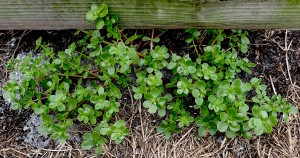
Purslane can survive a Florida winter if there isn’t much frost or freezing temperatures. Photo by Green Deane
A lot of mail I receive is about people not being able to find this highly esteemed vegetable. I have the opposite problem. I see it everywhere and want to take some home with me but I’ve got a lot already. This was one of two lovely patches growing along a fence in Port Charlotte, where I had a foraging class Sunday. This is classic growth: Sprawling, half-a-foot high, young tender leaves, thick stalks for pickling. Many consider it the most nutritious green on earth. Its journey to Florida no doubt took thousands of years. The plant is native to Iran and was grown and spread by the Romans. It came to the new world from Southern Europe. Oddly the United States is one of the few countries that does not readily view it as a commercial vegetable. It’s very common on the eastern side of the United States but less so as one moves west and northwest. To read more about purslane click here.
Sometimes you just have to take a picture. This past week while out pedaling with the C.R.A.B.S (Crusty Retired All recumBent Society) I looked past a retaining wall and saw a large bed of Oxalis. This is a non-native species with big leaves and large pink blossoms. Our native is much smaller with yellow blossoms (and in England there’s one with large leaves and a white blossom.) There are several hundred species and they are all edible. Most people and the internet mistakenly call them clovers which they are not. Three-leaf clovers are shaped like a T or a goatee and each leaf has a short stem. Oxalis leaves do not have short stems and are arranged equally around the main stem. I call them “rhubarb lite.” To read more about the Oxalis go here.
As one might suspect I grow wild plants in my garden as well as cultivated edibles. Last spring I planted one vine. When I was tilling the spoil over the holidays to plant my spring garden I found these roots. I have a big box of them and they are all from that one plant. What is most interesting is that the root does not smell like the rest of the plant at all. And as far as I know the root is not edible. Of course you’ll have to guess which species it is. It is also my intention to give the box of roots away so others can start new plants. I left a leaf or two on to help you sort it out.
Foraging Classes:
Sunday, January 10th, Spruce Creek Park, 6250 Ridgewood Ave. Port Orange, FL. 9 a.m.
Sunday, January 17th, 2016, Sunday, Nov. 15, Mead Garden, 1500 S. Denning Dr., Winter Park, FL, 9 a.m.
Sunday, Jan. 24th, George LeStrange Preserve, 4911 Ralls Road, Fort Pierce, FL, 9 a.m.
Sunday, Jan. 31st, Jervey Gantt Recreation Complex, 2390 SE 36th Ave., Ocala, FL, 9 a.m.
Sunday, Feb. 7th, Red Bug Slough Preserve, 5200 Beneva Road, Sarasota, FL, 9 a.m.
Sunday, Feb. 14, Mead Garden,1500 S. Denning Dr., Winter Park, FL, 9 a.m.
Sunday, March 6th, Florida State College, south campus, 11901 Beach Blvd., Jacksonville, 9 a.m.
Sunday, March 13th, Mead Garden, 1500 S. Denning Dr., Winter Park, FL, 9 a.m.
Saturday, March 19, Colby-Alderman Park: 1099 Massachusetts Street, Cassadaga, 9 a.m.
Saturday, March 26th, Dreher Park, 1200 Southern Blvd., West Palm Beach, 9 a.m.
Sunday, April 3rd, John Chestnut County Park: 2200 East Lake Road, Palm Harbor, FL, 9 a.m.
Sunday, April 10th, Wekiva State Park, 1800 Wekiwa Circle, Apopka, Florida 32712. 9 a.m.
Sunday, April 17th, Bayshore Live Oak Park, 2200 East Lake Road, Port Charlotte, FL. 9 a.m.
Sunday, April 24th, Wickham Park: 2500 Parkway Drive, Melbourne, FL 9 a.m.
To learn more about the foraging classes go here.
All of Green Deane’s videos are available for free on You Tube. They do have ads on them so every time you watch a Green Deane video I get a quarter of one cent. Four views, one cent. Not exactly a large money-maker but it helps pays for the newsletter. If you want to see the videos without ads and some in lightly better quality you can order the DVD set. It is nine DVDs with 15 videos on each. Many people want their own copy of the videos or they have a slow service and its easier to order then to watch them on-line. They make a good gift for that forager you know. Individual videos can also be ordered. You can order them by clicking on the button on the top right of this page or you can go here.
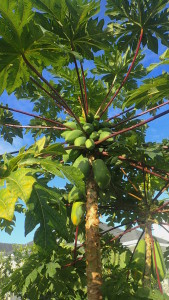
Yes, it’s a papaya but do you know what parts are edilbe? You would if you read the Green Deane Forum.
Want to identify a plant? Perhaps you’re looking for a foraging reference? You might have a UFO, an Unidentified Flowering Object, you want identified. On the Green Deane Forum we — including Green Deane and others from around the world — chat about foraging all year. And it’s not just about warm-weather plants or just North American flora. Many nations share common weeds so there’s a lot to talk about, such as the one to the left. There’s also more than weeds. The reference section has information for foraging around the world. There are also articles on food preservation, and forgotten skills from making bows to fermenting food. Recent topics include: Conyza and Chlorophyll. Can Anyone Tell Me The Name of This Plant? NJ Biennial. Crepis Japonica Nutritional Information? So Much Free Food! Berries! What Kind Of Shrub Is This? Oxalis Corymbosa. Water Hyssop Recipes. Where To Get LUS Groundnut Strain? Is This Lambs Quarters? Small Herb, Solanum americanum, Winter Fruits in Sanibel, Are These Plants Related to Canavalia maritima? Lawn Weed, Wild Cucumber, Melothria Pendula, Edibility of Flowers From Landscape Hibiscus, Primitive Survival Class, and Which Agave? You can join the forum by clicking on the button on the upper right hand side of this page.
This is newsletter 190.
To donate to the Green Deane Newsletter or website click here.

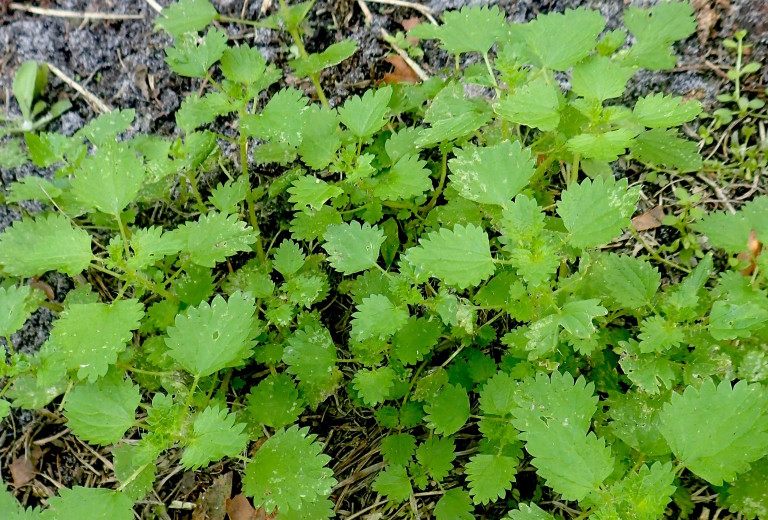
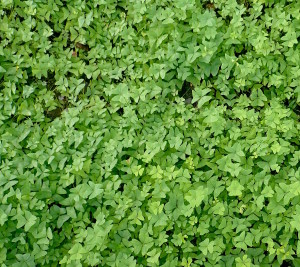
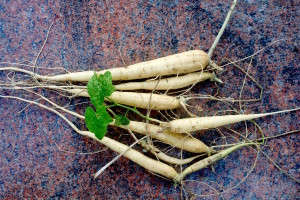
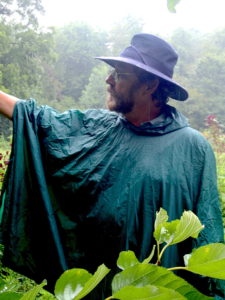


I thought from the shape of the leaves the mystery plant may be wild ginger, but then you said the roots you harvesated were not edible. SO I am still thinking.
Morning Green Dean!
It looks like tindora – ivy leaf gourd. We eat the root after boiling. It has a distinct potato flavour, and if you get a good one – and those look like very good ones – they are quite starchy and not fibrous.
“Let us sing in praise of Purslane” this nutritional powerhouse. It easily grows almost everywhere: vegetatively, seeding itself, and by cutting. Seeds can be carried by man, animal, wind and water. This wonderful plant can adapt so easily – grows vertically or creeps – in different environments that made me think it can as well tolerate external enemies. However, during my stay in Sana’a(Yemen), I tried three times to grow purslane. After the second week the stems thickened near the ground and growth seized. I’ve later on known of a pathogen “Dicotomophthora” which attacks the stems and infects the roots. This has been reported in USA, elsewhere, and in my country some have suffered from it.
It is said that purslane’s ability to adapt to a broad range of environmental conditions is due mainly to its use of a unique photosynthetic mechanism by which it can shift from well humid conditions to dry ones. Right was Thorea to speak of people who frequently starve not for want of necessaries but for want of luxuries.
Two places are famous for their people being exceptionally of good health and therefore live longer are those of yours beloved Crete and Koham of Japan. It is said this is mainly due to the high intake of alpha – linolenic acid (ALA) mainly found in purslane in their diet. Finally, as usual with eating habits, too much purslane may cause kidney stones due to oxalate precipitation. Our Sudanese proverb meant: that which exceeds its limit shall produce its opposite.
this is tindora? can I buy some? I will send a self address envelop etc!!